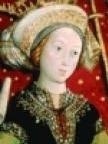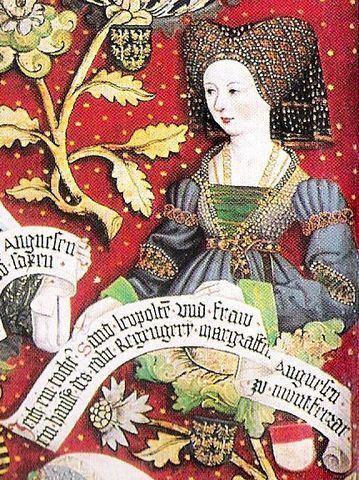Stamboom familie Lelieveldt/Lelivelt » Ranieri di Monferrato (1162-1183)
Persoonlijke gegevens Ranieri di Monferrato
Bron 1- Hij is geboren in het jaar 1162 in Montferrat, Italy.
- Beroep: Caesar.
- Hij is overleden in het jaar 1183, hij was toen 21 jaar oud.
- Een kind van William V Aleramici en Judit - Jutta von Österreich-Babenberg
Gezin van Ranieri di Monferrato
Notities over Ranieri di Monferrato
Renier of Montferrat (1162–1183; in Italian, Ranieri di Monferrato) was the fifth son of William V of Montferrat and Judith of Babenberg. He became son-in-law of the Byzantine Emperor Manuel I Komnenos and Caesar in 1180, and was later murdered in a Byzantine power-struggle. It was Manuel who suggested the marriage of his daughter Maria the Porphyrogenita to a son of William V. Since Conrad and Boniface were already married, and Frederick was in the priesthood, the only eligible son was the youngest, 17-year-old Renier. The Byzantine chronicler Niketas Choniates described him as handsome, blond (his hair "shone like the sun") and beardless. Renier arrived in Constantinople in autumn 1179 and soon afterwards accompnied Manuel on a military expedition. His marriage to the 27-year-old Maria took place at the Church of St Mary, Blachernai, in February 1180. The wedding was celebrated with lavish festivity including games in the Hippodrome of Constantinople, as fully described by the Latin Patriarch of Jerusalem, William of Tyre, who happened to be present.[1] Renier was given the title Caesar, was renamed John, and (according to some Western sources) was granted Thessalonica,[2] presumably as an estate for life, a pronoia. Maria was second in line to the throne, and had only been deprived of the succession by the birth of her much younger half-brother Alexios. Thus Renier became entangled in the perpetual power struggle around the Byzantine throne. With the death of Manuel in September 1180, the throne fell to the boy Alexios II, with his mother, the empress dowager Maria, acting as regent. The Empress caused a scandal by taking the protosebastos Alexios Komnenos as a lover. This, combined with her Latin-friendly views, triggered a plot to end the regency (or, as some describe it, to overthrow the Emperor) and give power to Maria and Renier. The plot was discovered, and several conspirators arrested. Maria and Renier sought refuge in the Hagia Sofia cathedral with some 150 of their followers. Fighting ensued, later dubbed the Holy War as it took place in that most holy church. Eventually, the conspirators were offered an amnesty to end the hostilities. Both the Emperor and the conspirators soon fell victim to another usurper, however, as Manuel's cousin and rival Andronikos Komnenos returned from exile, apparently with Maria's encouragement, and, more importantly, with an army in support. Andronikos' takeover was marked by the massacre of the Latin population that followed. Maria died soon afterwards, allegedly by poison: she was, no doubt, a potential focus of opposition to the usurper. Renier seems to have shared her fate,[3] though his death is noted by very few sources. Alexios II was forced to recognise Andronikos as his co-Emperor, and was later murdered. The Latin massacre had not been forgotten, twenty years later, when the leaders of the Fourth Crusade found reasons to divert their expedition to Constantinople. Later sources suggest that Renier's surviving older brother Boniface based his claim to Thessalonica on his late brother's title. http://en.wikipedia.org/wiki/Renier_of_Montferrat -------------------- http://en.wikipedia.org/wiki/Renier_of_Montferrat Renier of Montferrat (in Italian, Ranieri di Monferrato) (1162–1183) was the fifth son of William V of Montferrat and Judith of Babenberg. He became son-in-law of the Byzantine Emperor Manuel I Komnenos and Caesar in 1180, and was later murdered in a Byzantine power-struggle. It was Manuel who suggested the marriage of his daughter Maria the Porphyrogenita to a son of William V. Since Conrad and Boniface were already married, and Frederick was in the priesthood, the only eligible son was the youngest, 17-year-old Renier. The Byzantine chronicler Niketas Choniates described him as handsome, blond (his hair "shone like the sun") and beardless. Renier arrived in Constantinople in autumn 1179 and soon afterwards accompnied Manuel on a military expedition. His marriage to the 27-year-old Maria took place at the Church of St Mary, Blachernai, in February 1180. The wedding was celebrated with lavish festivity including games in the Hippodrome of Constantinople, as fully described by the Latin Patriarch of Jerusalem, William of Tyre, who happened to be present.[1] Renier was given the title Caesar, was renamed John, and (according to some Western sources) was granted Thessalonica,[2] presumably as an estate for life, a pronoia. Maria was second in line to the throne, and had only been deprived of the succession by the birth of her much younger half-brother Alexios. Thus Renier became entangled in the perpetual power struggle around the Byzantine throne. With the death of Manuel in September 1180, the throne fell to the boy Alexios II, with his mother, the empress dowager Maria, acting as regent. The Empress caused a scandal by taking the protosebastos Alexios Komnenos as a lover. This, combined with her Latin-friendly views, triggered a plot to end the regency (or, as some describe it, to overthrow the Emperor) and give power to Maria and Renier. The plot was discovered, and several conspirators arrested. Maria and Renier sought refuge in the Hagia Sofia cathedral with some 150 of their followers. Fighting ensued, later dubbed the Holy War as it took place in that most holy church. Eventually, the conspirators were offered an amnesty to end the hostilities. Both the Emperor and the conspirators soon fell victim to another usurper, however, as Manuel's cousin and rival Andronikos Komnenos returned from exile, apparently with Maria's encouragement, and, more importantly, with an army in support. Andronikos' takeover was marked by the massacre of the Latin population that followed. Maria died soon afterwards, allegedly by poison: she was, no doubt, a potential focus of opposition to the usurper. Renier seems to have shared her fate,[3] though his death is noted by very few sources.[4] Alexios II was forced to recognise Andronikos as his co-Emperor, and was later murdered. The Latin massacre had not been forgotten, twenty years later, when the leaders of the Fourth Crusade found reasons to divert their expedition to Constantinople. Later sources suggest that Renier's surviving older brother Boniface based his claim to Thessalonica on his late brother's title.[5] -------------------- http://genealogy.euweb.cz/italy/montfer.html ==Aleramici (di Montferrato) family== One Guglielmo, fl 925, was father of Ct Aleramo I di Savona, Marchese di Liguria and Piedmont, sn de Montferrat (954-991), titles confirmed by Emperor Otto I 23.3.967, +991; m.by VII.961 Gerberge of Italy (*945 +986) *A1. Oddone I, +before 991; m.Marie N **B1. Guglielmo III Marchese di Montferrato, +after 1031 *** ... ***C2. Oddone II Marchese di Montferrato (1044-84), +20.11.1084; m. Constanza di Savoia ****D1. Guglielmo IV Marchese di Montferrato (1084-1100), *ca 1040, +ca 1100; m.Aude/Otta d'Aglie (*ca 1045), dau.of Tibaldo d’Aglie (? Agledo) *****E1. Rainier II, Marchese di Montferrato (1100-35), *ca 1075, +1135-37; m.1105 Gisela de Bourgogne (*ca 1070 +after 1133) ******F1. Guglielmo V "il Vecchio", Marchese di Montferrato (1135-88/90), *ca 1110, +1188/91; m.before 28.3.1133 Judith von Babenberg (*ca 1115 +after 18.10.1168) ******* ... *******G3. '''Rainer di Montferrato, *1163, +of poisoning 1182;''' m.1180 Maria Komnene (*1152 +1182)
Tijdbalk Ranieri di Monferrato
Deze functionaliteit is alleen beschikbaar voor browsers met Javascript ondersteuning.
Klik op de namen voor meer informatie.
Gebruikte symbolen:  grootouders
grootouders
 ouders
ouders
 broers/zussen
broers/zussen
 kinderen
kinderen
 grootouders
grootouders
 ouders
ouders
 broers/zussen
broers/zussen
 kinderen
kinderen
Voorouders (en nakomelingen) van Ranieri di Monferrato
Ranieri di Monferrato | ||||||||||||||||||
Bronnen
- Geni World Family Tree, via https://www.myheritage.nl/research/colle..., 7 november 2018
Toegevoegd via een Record Match
The Geni Wereld Stamboom kan gevonden worden op www.Geni.com. Geni is eigendom van en wordt uitgevoerd door MyHeritage.
Over de familienaam Di Monferrato
- Bekijk de informatie die Genealogie Online heeft over de familienaam Di Monferrato.
- Bekijk de informatie die Open Archieven heeft over Di Monferrato.
- Bekijk in het Wie (onder)zoekt wie? register wie de familienaam Di Monferrato (onder)zoekt.
De publicatie Stamboom familie Lelieveldt/Lelivelt is opgesteld door Jan-Cees Lelieveldt.
Wilt u bij het overnemen van gegevens uit deze stamboom alstublieft een verwijzing naar de herkomst opnemen:
Jan-Cees Lelieveldt, "Stamboom familie Lelieveldt/Lelivelt", database, Genealogie Online (https://www.genealogieonline.nl/stamboom-familie-lelieveldt-lelivelt/I547525.php : benaderd 9 augustus 2025), "Ranieri di Monferrato (1162-1183)".
Jan-Cees Lelieveldt, "Stamboom familie Lelieveldt/Lelivelt", database, Genealogie Online (https://www.genealogieonline.nl/stamboom-familie-lelieveldt-lelivelt/I547525.php : benaderd 9 augustus 2025), "Ranieri di Monferrato (1162-1183)".



